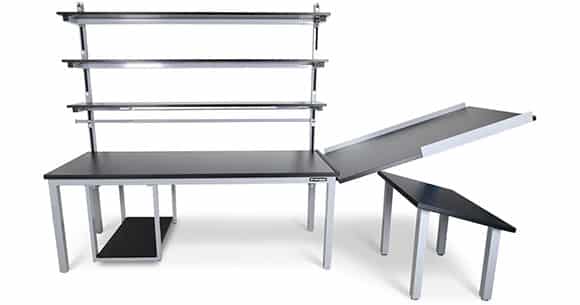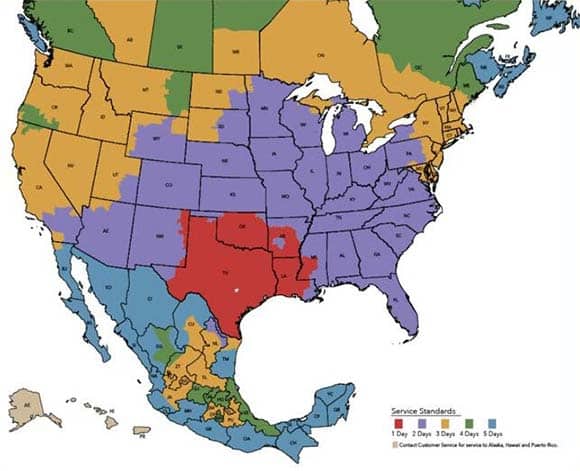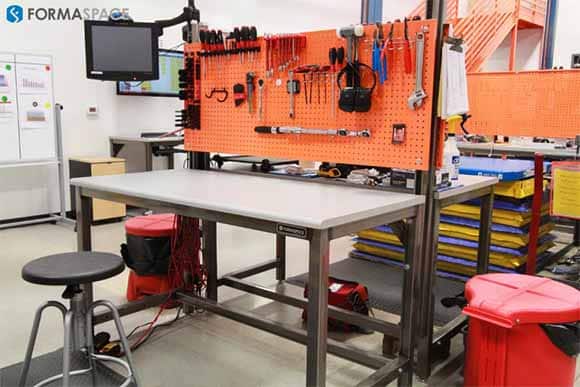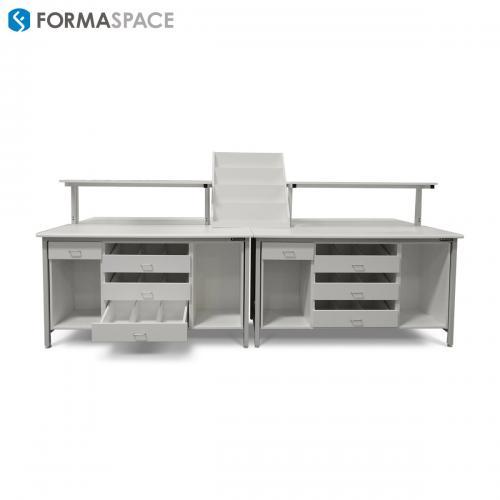In a world where customers are expecting faster (and often free) delivery, businesses are finding it more important than ever to closely manage their ground shipping operations. We take a look at how to address the twin challenges of reducing delivery times while decreasing shipping costs.


We’d now like to introduce you to Matt Rundblad, who oversees our Formaspace Customer Service and Shipping Operations. Matt started his career in shipping and receiving at some pretty well-known companies, including Dell, Pepsi, and Thermofisher. He’s been with Formaspace for five years now and can speak with authority on what he’s been able to accomplish to reduce Formaspace’s shipping costs.
We asked Matt to give his advice on some of the ways you can make your ground shipping operations more efficient and cut down on your freight shipping costs.
1. Before You Start: Analyze your Ground Shipping Operations Requirements
In this first step, you need to act with conviction. Pretend that you know nothing about the business and start asking yourself questions that challenge all your existing assumptions.
Why should you try this? The resulting, creative insights that come from questioning your standard operations might end up saving your company a lot of money. For example, if you have a product that is due for a redesign, could it be an inch narrower next time, which in turn, would allow more of the finished product to fit on a single shipping pallet?
What about weight savings? Could you switch to different materials or choose a lightweight composite design that would result in significantly lower shipping costs?
Do you have too many incidents where your products are being damaged during shipment? If so, look at reinforcing the product itself or changing the shipping container design to help protect it during transit.
These types of value, engineering investigations could provide substantial shipping cost savings throughout the entire product lifespan.
Next, you can look at your primary shipping patterns. Identify the major city pair shipping routes you use most. As we’ll see in a step further down the list, knowing your customer sales projections and freight shipping requirements for the next year or two can give you a much stronger hand when negotiating lower freight company shipping rates for your higher volume routes.
Finally, look at your customer’s requirements. If you are shipping to a company that has fixed receiving hours (such as a retail company), there may be hefty penalties if your delivery misses the delivery window requirements. In some case, the penalties can be as high as 3% of the PO, which can add up quickly. In these cases, it might make sense to pay a bit more to avoid penalties by shipping via an expedited service that guarantees on-time delivery, especially during bad weather or the holiday shipping season.
2. Create Efficient Shipping Operations with the Right Packing Tables and Shipping Station Configurations
When you are looking at the requirements for your shipping operations, don’t overlook how your packing tables and shipping stations are configured.
As we described in our article 10 Speedy Shipping Stations Set Up Tips, you’ll save money and time if you order fulfillment process is organized to avoid any unnecessary bottlenecks.
Packing and shipping personnel will make fewer errors if they have a clean, organized space to work — with the necessary packing supplies and equipment positioned in an easy-to-reach layout configuration.
Talk to your Formaspace Design Consultant about how you can improve the accuracy and throughput of your packing tables and shipping stations. We can also provide a Rapid Plant Assessment that takes a look at all aspects of your facility’s overall production layout and flow.
Whether you are a small company or a major enterprise, we have the experience to help you design a more efficient facility. Not convinced? Just ask one of our many industrial companies, including Kuene + Nagel, Amazon, Dell, Eli Lilly, Ford, Medtronic, and Toyota who have chosen Formaspace for their industrial furniture needs.

3. Understanding How Freight Categories and Rate Structures Affect Your Shipping Costs
As you are probably aware, ground transportation is generally divided into two categories:
“Truckload,” as the name implies, is a full truckload of freight, usually loaded with 24 or more pallets, weighing up to 45,000 pounds (or more). A typical truckload shipment travels from your shipping dock directly to the customer without intermediate stops.
“LTL” stands for “less-than-truckload” freight, e.g. a partial shipment that’s typically between 1 and 6 palettes. With LTL, it’s likely your freight may have to be loaded and unloaded (known as ‘touched’) at one or more transfer terminals on the way to your customer delivery.
Truckload and LTL shipping rates and freight categories are different as well.
Most LTL shipping rates are regulated by the National Motor Freight Traffic Association (MNFTA). Your total shipping cost is based on a calculation that takes your shipment’s freight classification, weight, density, and delivery distance into account. Since the most recent update in August 2017, there are nearly 140 classifications grouped into an 11-tier system (replacing the previous 9-tiers). Things can get even more complicated when you ship different classed products on a single palette. If this is a common situation for your shipments, it may be advantageous to negotiate a FAK (Freight all Kinds) rate with your carrier that accounts for your mixed shipments.
Full Truckload shipments are not regulated the way LTL shipments are. Instead, full truckload shipping rates on the open market can change on a daily, if not hourly, basis. (We’ll talk about negotiating long-term rates in the next section.)
There is also a concern in the shipping community about increasing freight costs due to new regulations, such as the federally-mandated Electronic Logging Device (ELD), which will be finally phased in (after many extensions) on April 1, 2018. In an attempt to cut down on dangerous truck drivers who drive longer hours than their truck logs indicate, the ELD system monitors the truck engine to create a driver’s hours of service (HOS) record that’s more resistant to tampering than manual record keeping. There is a widespread expectation that this will cause freight rates to rise, as rates will have to reflect the number of hours that drivers are actually driving. There’s also a concern that many truck drivers, and even entire companies, will leave the industry due to this new regulation, which could drive up rates due to reduced overall capacity.
4. Getting the Best Deal from Freight Companies for your Shipping Operations
Matt advises taking your time before rushing to use the name-brand carriers, such as FedEx and UPS. Take your time to see how your needs (determined in step 1 above) meet up with their offerings. Remember, they are high-volume companies, and if your shipping needs are different, it might not be a good match.

Before negotiating an agreement with the big carriers, such as FedEx and UPS, you should also take the time to understand how their rates change over time.
These companies tend to announce their rate increases for the following year during the fall. For example, in October 2017, FedEx announced an average 4.9% increase in its FedEx Express domestic and international services; FedEx Ground, FedEx Home Delivery, and FedEx Freight.
Holiday peak season surcharges are also becoming more common. Last fall, UPS implemented a 27-cent surcharge on residential package ground deliveries during the busy weeks in November and December. There are also other fees at work as well, such as fees for third-party billing on e-commerce shipments.
It’s also becoming harder to compare the freight rates from major companies like UPS and FedEx on an apples-to-apples basis. You’ll need to cost out your typical shipments using each company’s approach to dimensional weight pricing (DIM), which takes into account different zones and other factors.
Once you’ve educated yourself, you’ll be ready to sit down with major carriers like UPS and FedEx to find out if they can offer you the combination of rates and services, including damage shipment coverage, that’s right for you. Don’t be shy about letting them know they are competing for your business with other major carriers. You can also become a “bigger fish” during negotiations if you can get your own suppliers to ship their products (such as raw materials) to you on the same contract. You pay for these shipments already, and you’ll not only have much more negotiating clout, you’ll have greater visibility into the shipping rates you’ve been paying your suppliers.
There are also decisions to be made for individual shipments. For example, as you become familiar with your shipping companies’ practices, you may become more savvy about choosing which shipments to ship via expedited (priority) service and which to ship via economy rates. Looking at the routes the shipment will take (known as the “lanes” in the trucking industry) and the number of terminal stops (where your package will be transferred, a.k.a “touched,” to the warehouse and then to another truck) is important. Also, since most freight damage seems to happen at terminals, avoiding stops reduces the risk of damage, which is why Formaspace tends to ship its furniture via expedited (priority) shipments.

However, there have been cases where the economy route between certain city pairs has fewer stops and gets there faster than expedited shipments, so it pays to investigate!
As you can see, optimizing routes and saving money can get quite complicated. There is an increasing number of online tools, such as those from DAT that can help you compare shipping rates.
DAT and other online shipping services like Austin-based UShip can also match you up with a truck and a driver.
Finally, if all of this seems too complicated, you may want to investigate a reputable freight broker to help you.
5. Tips and Tricks for Shipping throughout the Year
Keeping track of the calendar will help you save money.
Time Critical Shipping
FedEx’s slogan at one time was “When It Absolutely, Positively Has to Be There Overnight.” And indeed, in many cases, you can have your freight delivered faster, for a price. These services, which have names like Expedited, Accelerated, or Guaranteed, cost more. But there are times when it makes sense to pay more, including:
- To avoid penalties for delivering outside the delivery window
- To reduce the number of terminal transfer “touches,” which increases the risk of damage (or theft) to shipments
- To avoid delivery delays during the holiday season or approaching bad weather
Holiday Shipping and Seasonal Weather
If it’s possible to ship before or after the holiday shipping season, do it. Not only are many shipments subject to additional holiday season fees, the chance that your shipment will be delayed, lost, or damaged goes up. For this reason, you might consider (as suggested above) to ship at an expedited rate and to carry a larger amount of insurance as well.
Bad weather can also wreak havoc on your shipping plans. Winter snow and ice can bring shipments to a standstill. And as Hurricanes Irma and Harvey reminded us in 2017, wind and flooding can leave entire regions without a transportation infrastructure for days or weeks at a time. So build in extra time for your shipment schedules during the winter if you are shipping to northern areas, and beware of the potential of hurricane season. It also might make sense to keep in contact with alternate shippers, in case the one you are primarily using is running into trouble.
Save Money Making Your Own Shipping Crates
Here at Formaspace, we build our shipping crates using recycled materials from our manufacturing processes. We recently wrote a guide on how to build your own shipping containers.
Not only can you save money by recycling materials, you can also optimize the size and weight of the crates, which in turn, can help you save money on freight costs.
Many companies send display wares to trade shows, and Formaspace is no exception. For trade shows, we build reusable shipping containers that are designed to be packed and unpacked easily for multiple uses.
Participate in the SmartWay Program
Creating shipping crates out of recycled materials is not the only sustainable business practice that can save you money.
You might want to investigate using eco-friendly shipping methods. For example, the Environmental Protection Agency (EPA) introduced a partnership with the freight industry, called the Smartway Transport Partnership. Freight companies participating in this program are working together to improve the overall efficiency of their logistics programs, in order to reduce fuel consumption and reduce pollution.
Managing Risk: Accidents, Errors, Theft, and Insurance Coverage
There are many things you can do to prevent damage from shipping accidents and errors in shipment orders.
Protect your Shipment from Damage and Theft
Your best defense against damage during shipment is adequate packaging to keep your product in new condition during shipment. When possible, keep all items together in one package to avoid getting separated. Ensure you use sufficient amounts of tight-fitting cushioning. Keep products constrained so they don’t shift around, which can lead to breakage and scratches.
Photograph the shipment during the packing process in case you need to make a claim for cargo damage or theft.
If you have valuable or irreplaceable shipments, you can reduce your exposure to theft by using a reputable freight company and choosing a level of expedited service that reduces, or ideally, eliminates any intermediate stops on the way.
Fill Out Bill of Lading (BOL) Forms Honestly and Correctly
Make sure your team members know the proper rules for filling out and declaring shipments. Don’t risk a hit to your reputation and the rate increase penalty that will come from improper freight declarations, such as incorrect classifications or lower than actual weights.
Be sure you include additional services that are needed for delivery (known as “accessorials”), such as the need for a lift gate for delivery locations without a loading dock.
Confirm the appropriate level of shipment is requested and not ordered out of habit. Expedited shipments that aren’t really necessary cost a lot of money.
Making a Freight Claim
Ground freight damages are governed by the Carmack Amendment.
While you may be in the right, according to the Carmack Amendment, you won’t be successful in making a claim for damaged or stolen freight if you are unable to establish that the shipment was in good condition when it was picked up (remember the photography suggestion above?) and that they were delivered in damaged condition, and that you can prove how much the damages cost. (Beyond this, there are still exceptions, such as Act of God, that can still get the freight company off the hook.)
Time is of the essence. Always unpack delivered goods as soon as possible to inspect for hidden damage (ideally in the presence of the freight company). Make claims as soon as possible.
Insurance Coverage from Reputable Companies
Given the limits on making successful freight claims, having adequate insurance coverage becomes more important when things go wrong, as is the reputation and customer service of the freight company. However, these claims can also take time, and you may be denied the full value of the lost or damaged shipment.
Sometimes it makes sense to get supplemental insurance from a provider other than your carrier.
Once again, you might want to increase your insurance coverage during busy holiday seasons or during seasonal winter weather, but just be sure that weather events and the like are actually covered in the fine print of your insurance rider.
Turn to Formaspace for Practical Advice
We hope you’ve found this guide to reducing your shipping costs helpful.
Formaspace has a lot more ways to help you.
You can turn to us for practical advice on how to make your manufacturing facilities, research laboratories, warehousing operations, and packing and shipping stations more efficient. We’re happy to share the years of experience we’ve gathered creating industrial furniture systems for today’s leading Fortune 500 and 100 companies.

It’s easy to get this assistance. Just contact one of our friendly Formaspace Design Consultants today. Fill out the contact form below and get the conversation started. You’ll be glad you did.










